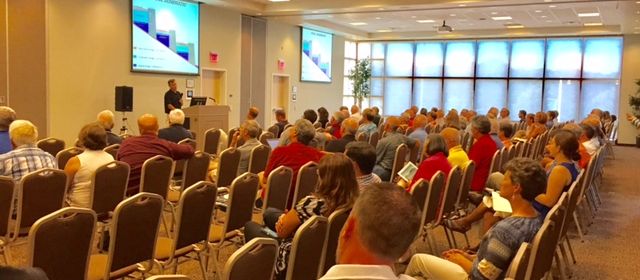U.S. Army Corps of Engineers Hosts Water Management Seminar

MJ Kneiser
Dozens of concerned citizens and civic leaders now have a better understanding of how the U.S. Army Corps of Engineers handles the management of water levels in the Savannah River Basin.
At a special seminar and workshop Monday evening at the Currahee Campus of North Georgia Technical College in Toccoa, Corps representatives along with representatives from the Georgia and South Carolina DNR, the U.S. Geological Survey and meteorologists were on hand to answer questions about the basin and its water levels.
Stan Simpson, Corps District Water Manager told the group managing the water levels is a juggling act.
He said during times of heavy rain, all three reservoirs have five feet of flood storage, but in the winter of 2015, the Corps ran out of flood storage during an unusual time of heavy rainfall and had to open the floodgates at Hartwell Dam and Thurmond Dam.
Simpson also reviewed the Corps four Drought Level plans.
Of the four levels, level four is the plan for the worst drought possible in which the water level on Lake Hartwell would be down to 625 feet above mean sea level.
But Simpson said if that happens, the Corps would keep water in Lake Hartwell longer than in the other two reservoir lakes.
“If we were ever to work our way all the way through the conservation pool to the point that I might say we’re empty, how are we going to approach using that water,” said Simpson. “The plan ended up saying at that point, it will be provided to the largest population in priority order, so it would be take out Russell first, Thurmond second and Hartwell last. If we ever get that far down the line, that’s the plan that’s currently in place.”
After the last drought in the summer and fall of 2016, Simpson said while we’ve had more rain since then and the lake levels are higher, the Corps continues to treat the summer water levels as if we are still in a drought.
“It looked like we were almost out of a drought from a weather perspective,” said Simpson. “From my perspective, we’re still in a drought so we’re still cutting back our releases until we’re back to two our trigger levels.”
Another speaker Monday evening was meteorologist Todd Hammil from the Southeast Forecast Center.
Hammil said it’s important for this area to get heavy rainfall during the winter months in order to bring reservoir levels up to normal by spring.
He said that didn’t happen this past winter, but recent rainfall is helping.
Hammil said we have moved out of the La Nina pattern that brought the drought and have moved into a more normal weather pattern for Northeast Georgia.
“We are actually looking right now at being in neutral conditions through the winter this year,” said Hammil. “For the last couple of years, other than that one El Nino, we’ve actually been in neutral conditions. The basin has stayed fairly stable. What we saw last fall was extraordinarily dry and the odds of us having that again are extraordinarily slim. But it does look like neutral conditions.”
Copies of the Corps’ Drought Management and Shoreline Management Plans are available by contacting the Hartwell Lake Project office at: 706-856-0300.
